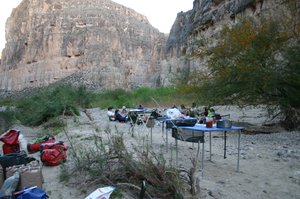Boquillas Canyon, United States
This article was researched and written by a student at Texas Tech University participating in the Encyclopedia of Earth's (EoE) Student Science Communication Project. The project encourages students in undergraduate and graduate programs to write about timely scientific issues under close faculty guidance. All articles have been reviewed by internal EoE editors, and by independent experts on each topic.
Contents
Introduction Boquillas Canyon, Big Bend National Park. (Photo by Alicia Freitag (Boquillas Canyon, United States) )
Boquillas Canyon is located in the southeast corner of Big Bend National Park. It is composed of high, layered cliffs around the U.S side of the Rio Grande and huge, angular mountains on the Mexican side of the river, which is part of the Maderas Del Carmen Protected Area.
A distinctive feature on the Texas side is a large sand drift half way up the cliffs, formed by the prevailing winds blowing sand up from the Rio Grande. At lower levels of water, the canyon may be explored by foot while a boat is needed in some areas of deeper water.
Boquillas means “little mouths ” in Spanish, so the canyon’s name probably originates from the narrow entrance to the canyon or for the many small holes in the canyon walls.
Recreation
Boquillas Canyon is a popular destination for tourists. The canyon os 57 kilometers (36 miles) long and provides many good campsites on both sides of the Rio Grande.
Hiking
The Boquillas Canyon Trail is a short trail (approximately 2.5 kilomters, 5 miles round trip) that is suitable for hiking by adults and children. Paddlers can choose from a variety of hikes through the many side canyons spread throughout the canyon.
Canoing and river rafting
 Camping in Boquillas Canyon. (Photo by Alicia Freitag)
Camping in Boquillas Canyon. (Photo by Alicia Freitag) The typical trip through Boquillas Canyon is 57 kilometers (36 miles) long. The put in for paddle trips is located at Rio Grande Village inside Big Bend National Park. The last take out is at Heath Canyon Ranch at the La Linda Crossing. The water is mostly calm throughout the canyon. About 2.5 kilomters (1.5 miles) before Heath Canyon Ranch there is a Class II rapid where the river turns sharply to the left, then back to the right. Typically, people spend 3-4 days traveling down the canyon. There are a number of good campsites along the way.
The Town of Boquillas del Carmen is just across the river from Rio Grande Village in Big Bend National Park and the ghost town of La Linda is just across the border from Heath Canyon Ranch on Highway FM 2627, but access to those Mexican towns is strictly prohibited by current federal regulation.
The best time to paddle the Rio Grande River through the Boquillas Canyon is early November through mid-March. In the summertime, water flow may be too low for rafting, but there is almost always adequate flow for canoers.
Fauna and flora
The Boquillas Canyon is home to many distinct types of wildlife. Javelina, deer, raccoons, raptors (mostly hawks) and vultures are in abundance while snakes, including rattlesnakes and water moccasins, may be seen during warm to hot months. Lucky paddlers may even be able to see a mountain lion. The area is characterized by certain vegetation such as: Lechuguilla (Agave lechuguilla), Creosotebush (Larrea tridentata), Tarbush (Flourensia cernua), Ocotillo (Fouquieria splendens), sotol (Dasylirion spp.), yucca (Yucca spp.), and certain other shrubs (Parthenium spp.; Acacia spp.; Mimosa spp.).
Environmental issues
The creation of factory towns called maquiladoras along the [[Rio Grande] River] have brought about increasing water pollution problems for areas along the Rio Grande including the Boquillas Canyon area. Illegal dumping of chemical waste and metals serve as a threat to many native species of animals and plants. Pollution is worse near heavily populated areas such as El Paso/Ciudad Juarez. The pollution from this area flows downstream into the Boquillas Canyon area. Certain governmental agencies such as the International Boundary and Water Commission serve to regulate pollution along the Rio Grande. Recently, a proposed 1,126 kilomter (700-mile) border fence along the U.S.-Mexico border has many environmentalists worried about increased pollution along the Rio Grande due to greater amounts of industry growth and lax environmental laws.
References and Further Reading
- McCord, Marc W. Boquillas Canyon of the Rio Grande, Texas. Southwest Paddler.
- The American Southwest. Boquillas Canyon, Big Bend National Park.
- Trails.com. Boquillas Canyon Trail.
- U.S. National Park Service. Floating Boquillas Canyon.